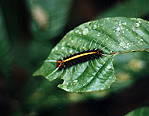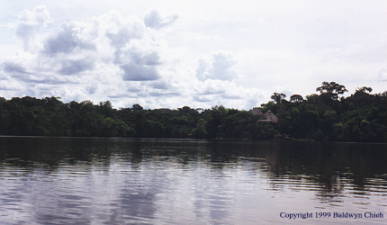

We meet Gus, our bilingual guide at the Quito airport, and board a small twin-prop plane for a thirty minute ride to Coca. The airport is tiny and dilapadated. Guttered old aircraft lie off to the side of the runway. Stepping off the plane, we feel the heat and humidity of the lowlands. We hoped into a pickup truck and had a short ride through Coca. The signs and buildings were old and rundown, and for small town, the streets seem to bustle with activity.
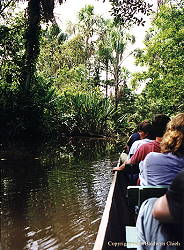 To get to La Selva, we board a long, outboard-motor driven canoe. The
heat of the jungle disappears, as we hit speeds of around 40 km/hr. The
lodge is about a hundred kilometers east, along the Napo River which is
a tributary of the Amazon. The water is slow-moving, and we glide smoothly
through it. It is incredibly muddy and brown, almost like coffee and cream
(we haven't had a decent cup of coffee in over a week). The thick green
forest comes right to the edge of the riverbanks, with only a couple of
gaps that reveal small, villages or bamboo huts.
To get to La Selva, we board a long, outboard-motor driven canoe. The
heat of the jungle disappears, as we hit speeds of around 40 km/hr. The
lodge is about a hundred kilometers east, along the Napo River which is
a tributary of the Amazon. The water is slow-moving, and we glide smoothly
through it. It is incredibly muddy and brown, almost like coffee and cream
(we haven't had a decent cup of coffee in over a week). The thick green
forest comes right to the edge of the riverbanks, with only a couple of
gaps that reveal small, villages or bamboo huts.
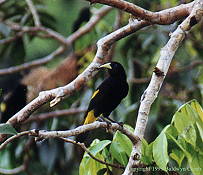 We reach our dock, and hike to get to our much smaller, dugout canoes. Our
native guide, Daniel, paddles us through the shallow river to Garzacocha Lake,
where La Selva sits. The noise of the jungle surrounded us. Crickets and
circadas provided the background, with various bird calls punctuating
the din. Some birds sounded like they just flew out of a pet store.
We strain to get a glimpse of the source of these sounds, but this is
definately
not the predator-free life of the Galápagos, and the birds use
the dense foilage for cover. We get off at the lodge's dock, and climb
the stairs to the huge hut that serves as the bar and lounge. Two ceiling
fans make this room the most comfortable spot in the lodge. We're
introduced to area, and assigned knee-high rubber boots that we find are
essential for most of our hikes. Outside, yellow-rumped caciques squawk
or whistle noisily in a neighbouring tree.
We reach our dock, and hike to get to our much smaller, dugout canoes. Our
native guide, Daniel, paddles us through the shallow river to Garzacocha Lake,
where La Selva sits. The noise of the jungle surrounded us. Crickets and
circadas provided the background, with various bird calls punctuating
the din. Some birds sounded like they just flew out of a pet store.
We strain to get a glimpse of the source of these sounds, but this is
definately
not the predator-free life of the Galápagos, and the birds use
the dense foilage for cover. We get off at the lodge's dock, and climb
the stairs to the huge hut that serves as the bar and lounge. Two ceiling
fans make this room the most comfortable spot in the lodge. We're
introduced to area, and assigned knee-high rubber boots that we find are
essential for most of our hikes. Outside, yellow-rumped caciques squawk
or whistle noisily in a neighbouring tree.
Our room is a sturdy bamboo hut, with running cold water, but no electricity. A mosquito net hangs over the bed, and it's clear that the room provides some shelter, but certainly won't keep the jungle out.
After the hike, we climb into the dugout canoes again, and head along Mandicocha Lake, trying to identify some of the birds. Blue and red macaws screech loudly, and take flight overheads. Toucans give away their identity easily with their ungainly beak, providing a very distinct profile.
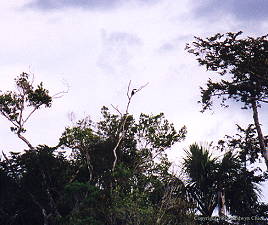
One of my favourite birds from the jungle, is the hoatzin. A strange pheasant looking creature, it is guessed to be the closest relative to the teradactyl, and hatches with claws on its wings. The bird feeds off of leaves, and gives off the strangest grunting noise, sounding more like a mammal than a bird. We arrive at the lodge's docks again, as the sun sets behind the hut.
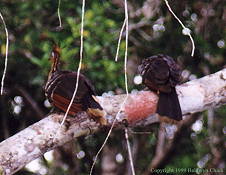
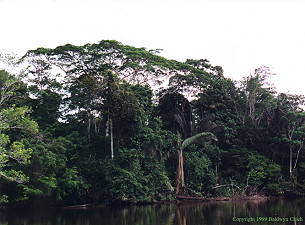
|
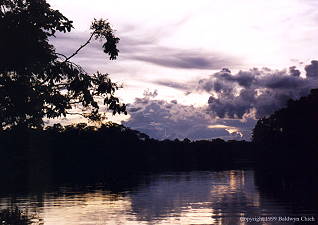
|
